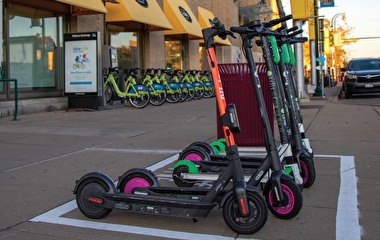Electric scooters let riders move quickly between the roadway and the sidewalk, but these sometimes-unpredictable travel patterns can pose risk for riders and the people around them. Making scooters smarter is the goal of a new U of M research project funded by the National Science Foundation (NSF). Under the $1.2 million Cyber-Physical Systems grant, a cross-disciplinary team will study smart tracking systems on scooters for ensuring safe and smooth interaction with other vehicles and pedestrians.
Professor Rajesh Rajamani of the Department of Mechanical Engineering is the principal investigator. Nichole Morris, director of the HumanFIRST Laboratory, and Ju Sun, assistant professor in the Department of Computer Science and Engineering, are co-investigators.
“Our plan is to develop a platform technology that has applications beyond the scooter to other transportation systems for vulnerable transportation users, such as bicyclists and motorcyclists,” Rajamani says. “It could also be used for low-cost vehicles in developing countries and for other autonomous platforms such as indoor robots.”
The research builds on earlier work by Rajamani and Morris that developed an alert system to protect cyclists from cars. The initial prototype was developed with funding from the Roadway Safety Institute, and additional work and testing continued with a nearly $1 million NSF grant.
The smart e-scooter system will consist of inexpensive sensors, active-sensing-based estimation algorithms, and deep-learning-based robust image processing to enable trajectory tracking of all nearby vehicles on the road.
If the system detects the danger of a scooter-vehicle collision, it will automatically send an audio-visual alert to nearby car drivers to make them aware of the scooter. The system also monitors the scooter rider’s behavior, provides real-time feedback to improve rider compliance with traffic signals and sidewalk rules, and documents the information as a part of the rider’s safety record.
“One key attractive feature of the system is that it will be inexpensive—less than $500,” Rajamani says. “Also, it will be immediately useful on today’s roads without requiring vehicles to be equipped with additional technology.” Those qualities improve the potential for commercialization.
The team will conduct research to develop two novel vehicle-tracking technologies. One will be based on a low-cost, single-beam laser sensor, and the other on a low-cost, low-density Lidar sensor.
The computer vision system will handle rain, snow, and low lighting—factors that pose a major challenge by corrupting normal image data. New robust deep-learning-based recognition techniques will be developed that can effectively deal with corrupted image data sets. “This will allow for mixed corruption types, varying severity, and possible corruptions in the training data itself,” Sun says.
The project will also include human subject studies to evaluate the effectiveness of a variety of audio and visual mechanisms for alerting the motorist and the scooter rider. These will include innovations such as visual cues of biological motion on the scooter to help drivers locate it.
“E-scooter riders lack all the distinguishable movement cues that pedestrians and bicyclists display, making it harder to recognize them and predict their speeds, so augmenting these biological cues is an important goal of the study,” Morris says.



